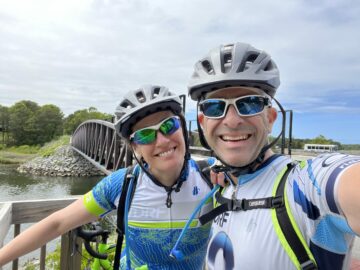
If you’re a distributor, you know that fleet performance has a direct impact on your financial performance, your ability to differentiate yourself from the competition, and your ability to deliver an enhanced customer experience. What separates the leaders from the laggards in the industry? What are some signs that a distributor may not be employing route planning best practices? And what are those best practices? Those are the main questions I discussed with Brad Bradley, Senior Sales Executive at Descartes Systems Group, on a recent episode of Talking Logistics.
Fleet Performance Disparities
There can be significant disparities in fleet performance between distributors even if they are using the same route planning solution. Why does this happen?
Brad indicates one key variable is measurement. For example, did the driver show up on time, did they go to all of their stops, and in the right sequence? Are you measuring the performance of planners to find inefficiencies for further training? Is the optimizer properly tuned for your changing environment, and is the planner using it properly?
“A lot of people in the industry don’t use these measurements, and what doesn’t get measured can’t be managed properly,” says Brad.
Ignoring Best Practices
How do you know if a distributor is not using best practices? What are the telltale signs they are not?
Brad suggests if a planner is changing more than 10 percent of the stops, there are problems. These may be data problems, optimizer configuration problems, or the planner may not understand the software and may need more training. “Observing the planner will tell you if the planner is using the optimizer properly and if it is being effective.”
The second area to consider is reporting, Brad notes. With seasonality, changing sales strategies and other variables, you must be able to understand what the planner did and what the optimizer did to adequately measure the performance of each in the current environment. These reports will point out where tuning and/or training may produce better outcomes.
Best Practices
What are those best practices? Brad mentions that observing and reporting on planner and optimizer performance is critical, as he explains in the short clip below:
[embedded content]
He also notes that examining data quality is important. For example, you may not have good time window data. “One of the challenges in collecting time window data is that sometimes drivers actually know the ideal time to go make a delivery if you’re going to a recurring customer, but there’s no digital, programmatic way to collect that data,” explains Brad. “So, you can offer the driver, via a mobile application, a questionnaire to say ‘What’s the best time to make the delivery?’ and digitize that information to give back to the planner. The planner is now part of this closed-loop cycle of continuously improving the data so that they want to use the optimizer; they now have the mechanism to improve data quality and not have that as a reason to not use the optimizer.”
Brad also states that if your route planning isn’t centralized, or at least regionalized, it’s very hard to optimize the results. “You want full-time planners who can see the big picture and best leverage the optimizer,” he says.
The third best practice Brad mentions is ongoing training. With software vendors continually upgrading the software with new features, as well as with turnover among planners, a continuous training program is critical to make sure planners are able to maximize the performance of the solution.
Benefits of Improved Performance
I asked Brad what benefits distributors are achieving with improved performance. He indicates cost savings are the key result. “Going from manual planning to an automated system will provide 10% to 15% savings in transportation,” he says. “The challenge is you might not realize those savings in production due to the symptoms I mentioned earlier, so it’s important to go back and examine if you’re using best practices.
“On-time percentage should improve as well. It’s also a basis for providing a good customer service experience because you can provide more accurate delivery information.”
Getting Started
I asked Brad how companies should approach implementing route planning technology and best practices. He provided some good suggestions, so I recommend you watch the full episode for his insights and advice. Then keep the conversation going by posting a comment and sharing your perspective on this topic.
- SEO Powered Content & PR Distribution. Get Amplified Today.
- PlatoData.Network Vertical Generative Ai. Empower Yourself. Access Here.
- PlatoAiStream. Web3 Intelligence. Knowledge Amplified. Access Here.
- PlatoESG. Carbon, CleanTech, Energy, Environment, Solar, Waste Management. Access Here.
- PlatoHealth. Biotech and Clinical Trials Intelligence. Access Here.
- Source: https://talkinglogistics.com/2023/12/14/how-can-b2b-distributors-improve-fleet-performance/
- :has
- :is
- :not
- :where
- $UP
- 10
- 15%
- a
- ability
- Able
- accurate
- achieving
- actually
- adequately
- advice
- All
- also
- among
- an
- and
- Application
- approach
- ARE
- AREA
- AS
- asked
- At
- Automated
- B2B
- back
- basis
- BE
- because
- being
- below
- benefits
- BEST
- best practices
- Better
- between
- Big
- Big Picture
- brad
- but
- by
- CAN
- centralized
- challenge
- challenges
- changing
- collect
- Collecting
- comment
- Companies
- competition
- Configuration
- Consider
- content
- continually
- continuous
- continuously
- Conversation
- Cost
- cost savings
- critical
- Current
- customer
- customer experience
- Customer Service
- cycle
- data
- data quality
- deliver
- delivery
- DID
- differentiate
- digital
- digitize
- direct
- discussed
- distributor
- distributors
- do
- does
- Doesn’t
- Dont
- driver
- drivers
- due
- each
- Earlier
- Effective
- embedded
- employing
- enhanced
- Environment
- episode
- Even
- examine
- Examining
- example
- executive
- experience
- Explains
- Features
- financial
- financial performance
- Find
- FLEET
- For
- from
- full
- further
- get
- Give
- Go
- going
- good
- happen
- Hard
- Have
- he
- his
- How
- HTTPS
- i
- ideal
- if
- Impact
- implementing
- important
- improve
- improved
- improving
- in
- indicates
- industry
- inefficiencies
- information
- insights
- IT
- jpg
- Keep
- Key
- Know
- laggards
- leaders
- least
- Leverage
- Lot
- Main
- make
- managed
- manual
- Maximize
- May..
- measure
- measured
- measurement
- measurements
- measuring
- mechanism
- mentioned
- mentions
- might
- Mobile
- more
- must
- Need
- New
- New Features
- no
- Notes
- now
- observing
- of
- offer
- on
- ONE
- ongoing
- Optimize
- or
- Other
- out
- outcomes
- part
- People
- percent
- percentage
- performance
- perspective
- picture
- planning
- plato
- Plato Data Intelligence
- PlatoData
- player
- Point
- practice
- practices
- problems
- produce
- Production
- Program
- programmatic
- properly
- provide
- provided
- providing
- quality
- Questions
- realize
- reason
- recommend
- recurring
- Reporting
- Reports
- result
- Results
- right
- Route
- sales
- Sales Strategies
- same
- Savings
- say
- says
- Second
- see
- senior
- Sequence
- service
- sharing
- Short
- should
- show
- significant
- Signs
- So
- Software
- solution
- some
- sometimes
- States
- Stops
- strategies
- Suggests
- sure
- Symptoms
- system
- Systems
- talking
- Technology
- tell
- than
- that
- The
- their
- then
- There.
- These
- they
- Third
- this
- those
- time
- to
- topic
- Training
- transportation
- tuned
- tuning
- turnover
- understand
- use
- using
- variable
- variables
- vendors
- very
- via
- Video
- want
- Watch
- Way..
- WELL
- What
- WHO
- why
- will
- window
- with
- you
- Your
- yourself
- youtube
- zephyrnet












